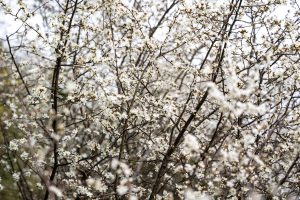Why we need more trees (and bushes)
Having recently moved house, it has quickly become evident that the number of birds visiting the new garden is significantly down on my previous garden. There are a number of reasons for this, but the most noticeable one is a lack of trees and bushes close to the feeders. The result of this lack of bird activity is a noticeable drop in the amount of bird food of various types being eaten.
Previously the feeders were surrounded by thick mature hedges made up of a wide variety of tree and bush species. As a result, birds would land in the hedges and trees and dart back and forth to the feeders in an almost constant stream. All this activity resulted in the need to refill feeders and bird tables several times each day. Something I was only too pleased to do as the numbers and variety made for good results to report on my Garden Birdwatch.
As winter got closer, the demand for food increased, with resident birds being joined by migrants who quickly took advantage of what was on offer. So it was apt that on World Migratory Bird Day, and blessed by ideal weather to tidy and fill feeders, the need for more cover became even more evident. For the first time, I had the opportunity to take a good look at the cover on offer to the birds. It was then that the penny dropped as to why we are using far less food.
A few years ago, I was given a small, clear plastic window feeder (no, it wasn't to feed windows). This simple item proved to be one of the most successful feeders I owned, not because of its design but because it was located between two tall and mature shrubs. This dense cover proved invaluable to the birds, who seemed determined to empty the feeder as quickly as possible. It was the use of this device that proved the value of cover when feeding garden birds. If nothing else, this proved the importance of cover in a garden.
With this in mind, the plan at this new location is to plant as many trees and shrubs as possible. It might seem obvious to many, but the last few months have convinced me that we need many more trees. No, of course, you can’t plant trees close to buildings, and even shrubs and large bushes can cause problems with footings, but with careful planning, they can, and should, be part of all gardens in much the same way as water should.
When completed, I hope the result will be more birds, a broader range of species, and a reduction in Co2. Add to that the benefits of having a greener environment on our doorstep, one that has been proven to improve mental and physical health, and it seems to be a win-win situation.
© Phil Pickin
Previously the feeders were surrounded by thick mature hedges made up of a wide variety of tree and bush species. As a result, birds would land in the hedges and trees and dart back and forth to the feeders in an almost constant stream. All this activity resulted in the need to refill feeders and bird tables several times each day. Something I was only too pleased to do as the numbers and variety made for good results to report on my Garden Birdwatch.
As winter got closer, the demand for food increased, with resident birds being joined by migrants who quickly took advantage of what was on offer. So it was apt that on World Migratory Bird Day, and blessed by ideal weather to tidy and fill feeders, the need for more cover became even more evident. For the first time, I had the opportunity to take a good look at the cover on offer to the birds. It was then that the penny dropped as to why we are using far less food.
A few years ago, I was given a small, clear plastic window feeder (no, it wasn't to feed windows). This simple item proved to be one of the most successful feeders I owned, not because of its design but because it was located between two tall and mature shrubs. This dense cover proved invaluable to the birds, who seemed determined to empty the feeder as quickly as possible. It was the use of this device that proved the value of cover when feeding garden birds. If nothing else, this proved the importance of cover in a garden.
With this in mind, the plan at this new location is to plant as many trees and shrubs as possible. It might seem obvious to many, but the last few months have convinced me that we need many more trees. No, of course, you can’t plant trees close to buildings, and even shrubs and large bushes can cause problems with footings, but with careful planning, they can, and should, be part of all gardens in much the same way as water should.
When completed, I hope the result will be more birds, a broader range of species, and a reduction in Co2. Add to that the benefits of having a greener environment on our doorstep, one that has been proven to improve mental and physical health, and it seems to be a win-win situation.
© Phil Pickin



